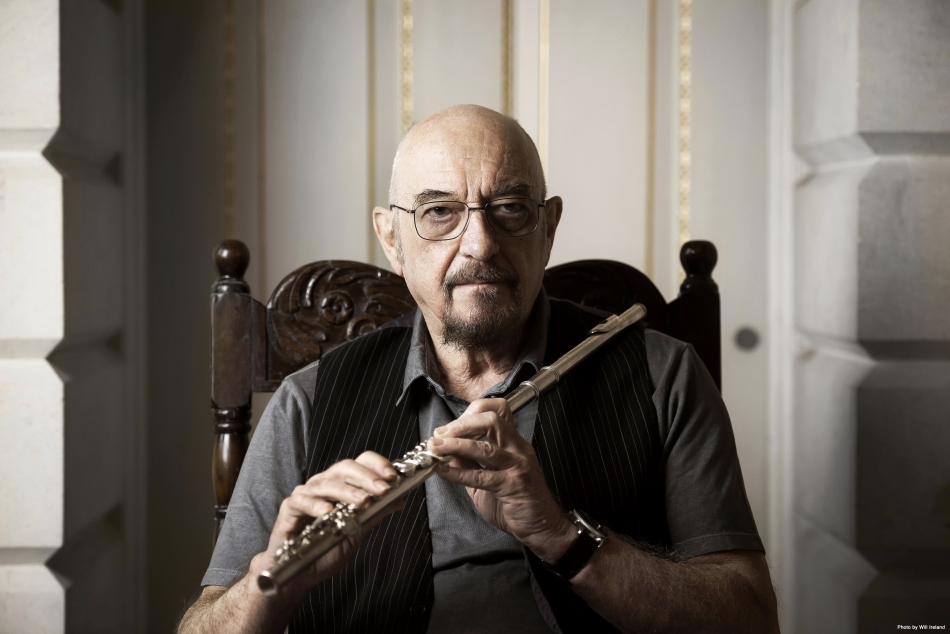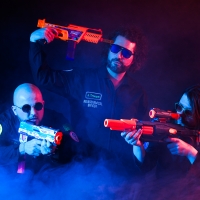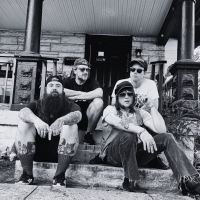Singer/songwriter/multi-instrumentalist Ian Anderson is an artist who likely needs no introduction. As the founding mastermind behind legendary progressive/folk/blues rock troupe Jethro Tull, he’s spearheaded some of the most iconic and influential popular music of the last half-century. (For more on that, feel free to check out my book on the band: On Track: Jethro Tull.)
Despite being considerably prolific from the early 1970s to the early 2000s, Jethro Tull hasn’t released a new studio album in almost twenty years. That is, until now, as the group’s first new record since 2003’s The Jethro Tull Christmas Album—The Zealot Gene— is set to release on January 28th, 2022 via Inside Out Music.
In preparation for the LP, I spoke with Anderson about the creation of the collection (including working with the latest line-up), the decision to categorize it as a Jethro Tull release, the impact of COVID-19 on the writing and recording processes, and much more!
You’ve stated that The Zealot Gene is considered a Jethro Tull release because it’s more of a “band album,” with the longest line-up the group’s ever had. Obviously, it feels like a natural progression from your most recent solo work, but do you feel that there are any connections to prior Jethro Tull LPs?
I really don’t think in those terms when I’m writing music. I think I’m always consumed with what it is I’m trying to do in the moment. I don’t try to replicate or draw upon earlier work; that doesn’t figure into my process. Subsequently, though, you might sit back and take a more objective look at it and draw some comparisons. I’m kind of on my guard a little bit when it comes to writing lyrics in that I don’t want to subconsciously parrot references or phrases that I’ve used before. I try to avoid that most, but I’m not really fretting over it or obsessing over trying to have continuity or avoid it. I just get on with the job of writing whatever’s coming into my head.
That’s a great way to approach it.
We always work with arrangements early on, so each song starts to have an identity pretty early on. That is the way in which I prefer to work. To be doing things carefully in preparation prior to going into a recording studio and pressing the button and a red light coming on. By then, I hope that we all know what we’re playing and have it all worked out. Maybe some room for a little leeway or improvisation. Having a clear-cut arrangement that gives the song its own identity is quite important before getting to the master recording.
From what I understand, you had a lot of it worked out and recorded pre-COVID.
We recorded seven tracks in 2017, and four of them I’d completed and mixed during that year. Then, we were on the road so much, and trying to get the guys to give up their free days in-between didn’t seem like the right opportunity for people to come back into it relaxed and with a clear head. So, I kept putting it off and, you know, being lazy. I’m sure that’s the simple way to put it. The intention to get on with it again in 2020 was completely sidelined by the emergence of the pandemic and the fact that we couldn’t get together in the studio. By the beginning of this year, I gave up hope that we’d be together in the studio again, so I decided to just finish the last five songs—which I’d already written but hadn’t recorded—so I recorded them alone at home with an acoustic guitar and a few other instruments.
Oh, okay.
Then, the other guys sent in their audio files to be incorporated into the mix. Things they’d recorded in their own homes, so it was finished in a rather distant way, which I normally wouldn’t feel comfortable with, but I think that the end result gained a degree of dynamic variation and contrast. The fact that some of them are not played together as a band probably turned out to be a good thing. That light and shade in terms of instrumentation, which was not the case on Homo Erraticus [2014] because all of the guys played on all of the tracks all of the time [laughs]. Sometimes, it’s quite nice to step away from drums, bass, and electric guitars and just have some space.
Absolutely.
That’s perhaps part of the success of Aqualung [1971]. It has a few rock songs on it and a few band tracks and then a bunch of songs that are just me in the studio with an acoustic guitar and then the other guys adding something later. I didn’t set out to do it that way on The Zealot Gene, though. The pandemic made the decision for me.
It certainly didn’t hurt the album in any way.
There’s a slight advantage to having changed the methodology for the last five songs. As I said, they were already written; I didn’t change anything in the music or the lyrics. It’s just that all that I had for the initial demos was me strumming an acoustic guitar and singing a few words, so I just did that in a slightly more professional context and got through them rather than sharing it amongst the band for a proper rehearsal and recording experience.
Obviously, everyone who’s playing on it has been playing with you for many years, whether on solo albums or as part of the live Jethro Tull band. That is, except for guitarist Joe Parrish, who replaced Florian Opahle a year or two ago.
Right. Joe was somebody that we found through a friend of a friend. Someone directed me to YouTube videos that he’d done, and I could see that he was steeped in progressive rock and folk music. He certainly had the technical skills, too. Of course, having been to music college for a few years and making some YouTube videos doesn’t necessarily make someone equipped for being a part of an international touring band, and Joe had never really performed in front of anybody. He literally was just playing to a camera on his computer. So, it was quite a big jump for him to go from that to performing on stage during the only two concerts he did (in Barcelona and Madrid) before the pandemic really hit.
Wow.
Those two shows must’ve been scary for him, but by the second night, he was settling in. These days, he convinces me that he’s actually enjoying himself [laughs]. That’s good.
Quite. You’ve said that The Zealot Gene continues your exploration of religion. Do you see it as connected to Aqualung or anything else that also dealt with religious quandaries?
No, not really. Every album is its own thing and quickly takes on its own form. There may end up being some sort of relationship that you see when you look at the finished product, but I’m not setting out to build in any moments that are indicative of earlier work or other artists’ work. That said, subject matter is fair enough to go back and reexamine with different words and music.
Definitely. Did you always have the title in mind?
I didn’t have the title in mind at first, but the general topic of the album was there after about three weeks of working on it. As a text document, it was all there so that I could stay on track.
What led to “Sad City Sisters” and “Shoshana Sleeping” becoming the first two singles and music videos?
Well, now we’re getting into the realm of marketing and promotion that I don’t personally derive any pleasure from. It’s when you hand it over to someone else to get their expertise and opinion. Contrary to rumor, I’m not a control freak all of the time, so the guys at the record company are supposed to know about this stuff and they suggested three songs that would be the subject of some promotional videos. If I was asked to choose three songs to introduce people to the album, I would’ve chosen three different songs, but that’s not my role and I mentioned it but they had their own ideas. I said, “Okay, fine, we’ll do it your way.” They felt that it was better to have songs that were better teasers rather than give away some pieces that are more musically emphatic. That’s fair enough. I understand the reasoning behind it.
Ah, I see.
The video for “Shoshana Sleeping” was done by somebody I’ve never met. It was something the label came up with and it seemed like a good idea. “Sad City Sisters” was done by Sam Chegini, whom I think was introduced to me by Jakko Jakszyk. He’d done a video for Jakko and I mentioned that to Warner Bros. when they wanted to do something for Aqualung. Sam did that and then I put his name forward to Sony in London as a person who might be able to turn around fairly quickly a video for one of the tracks.
That’s great. Speaking of labels, what made you sign with Inside Out Music for this one? I read that they reminded you of Chrysalis Records?
Well, maybe in that they’re a boutique label that specializes in progressive rock, and they’re just a few people in a couple of rooms. Because Sony now owns Inside Out, I’m dealing with both right now, and we have the best of both worlds. We went to six different companies, and I made my choice not based on who was offering the most money but who seemed to have the best approach to it. It came down to two and it was a difficult choice.
I’m sure. I’ve also noticed that in recent years, you’ve done a lot of guest work for artists like Tim Bowness, Robby Steinhardt, and Louise Patricia Crane. Do you find yourself getting more of the opportunities now compared to decades ago, and do you enjoy it more?
Part of the reason is that I’ve often worked with people who aren’t extremely well known, so their work didn’t reach very far, whereas now the internet gives us access to everything so it’s easier for newer voices to be heard. Maybe it’s being noticed more than it used to be. I experienced something of an upswing in general requests during the last couple of years because people are in their studios, and they imagine that I have more time on my hands. Obviously, I have to decline most things because I simply don’t have the time to do them. Or, it’s something that doesn’t really appeal to me. I’m more inclined to agree to something that isn’t really my cup of tea because it’s more of a challenge.
Oh?
I’ve done some weird ones over the years, you know, like playing with a thrash metal band from New York City or on William Shatner’s Christmas Album [2018’s Shatner Claus]. You look at it and think, Oh, that’s not really my thing, but then you take a second look at it and realize that that’s exactly why you should do it. To see if you can rise to the challenge of something that’s outside of your comfort zone. I’ve been asked to play on a lot of things that are really sophisticated, and I know that it’s going to take me so many hours to try to understand it and be able to play it well enough. Technically, I can’t cope with it.
That’s an interesting reason to not do it.
It is. I’m usually looking for things that let me use a degree of improvisation and my own judgment to add a little decoration to what’s already there. I certainly don’t want to “collaborate” with other musicians in terms of writing songs together. I’m a loner in that sense, and I want to push myself even with my own new music. You don’t want to make it too easy; you’ve got to step up to the occasion. That’s true for the other guys in the band as well. I’m not making it easy for them, but I’m usually confident that they’ll understand the music and notate it and work from charts. That’s how they focus on learning it, whereas I memorize things.
It’s great that you’re still finding ways to step out of your comfort zone. So, what’s next? Any plans to start work on the follow-up?
I had a long discussion with the boss of the record company a few weeks ago and we talked about a new album and decided that the release date would be the end of March 2023. I explained to him that on the first of January 2022, at 9:00 AM, I would do what I’d done with the last four recording projects: start working on something with an empty mind. Nothing preplanned. The important thing is to have a moment where you’re open to something a little more inspirational if you’re lucky. So, on the first of January, I’ll give it a couple of hours and if nothing is happening, I’ll take a break and try again. I would hope that within two or three days, I’ll have two or three ideas and then I can complete most of the writing process over the subsequent three or four weeks. Make some initial demos to send to the other musicians and hope that we can get on during the course of next year to record it. I’ve no idea what it’s going to be.
Well, I can’t wait to hear it. Thanks again, Ian.
Thanks, Jordan.
You can preorder The Zealot Gene here. For more on Jethro Tull, see the following links:
Official Website
Facebook
Twitter
Spotify




